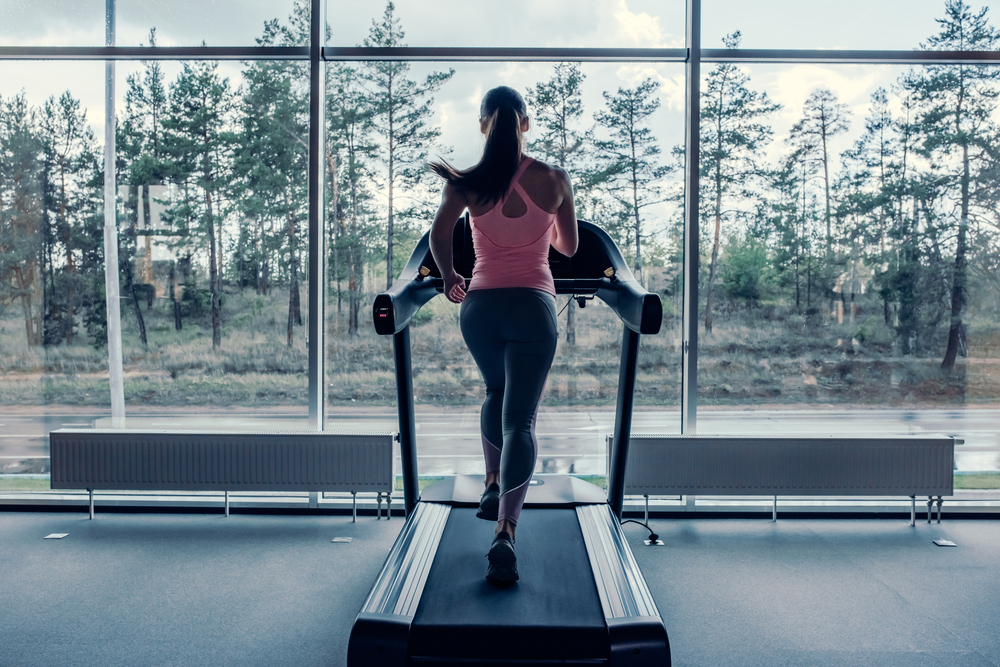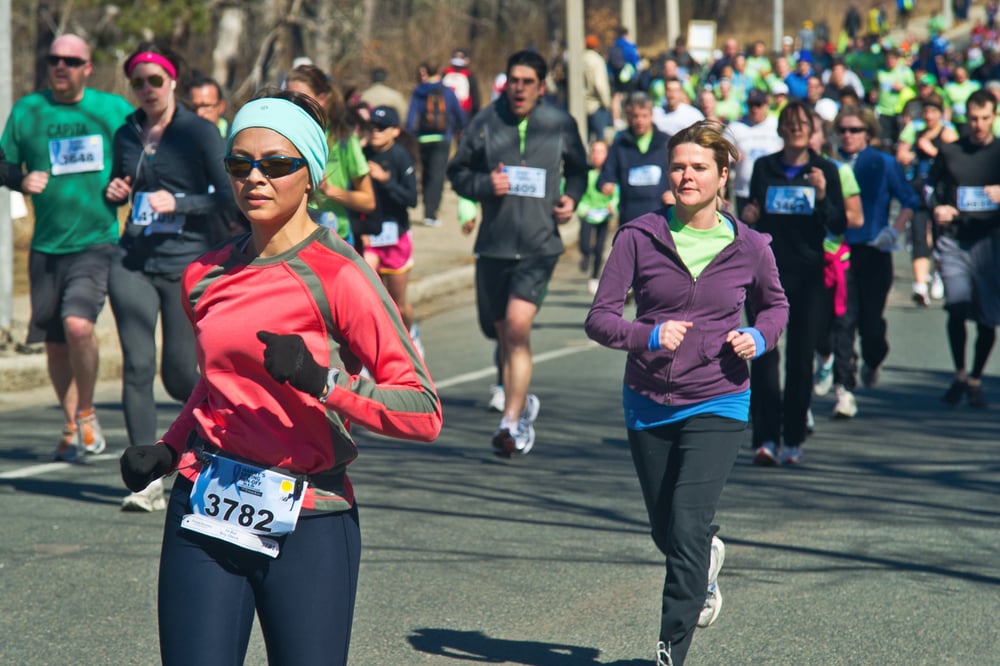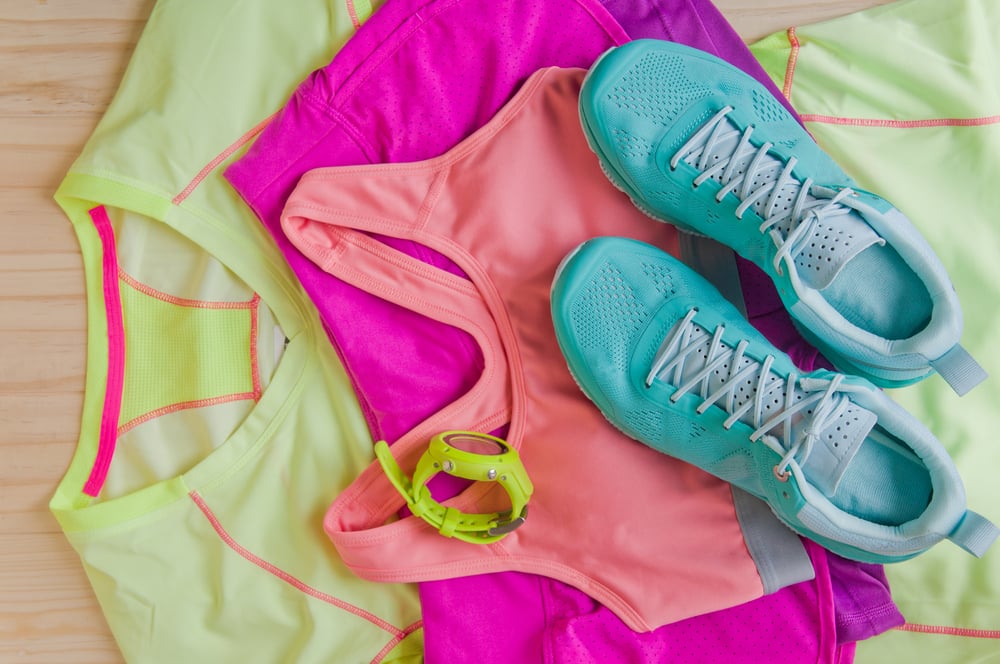The first step toward reaching any goal is to seek information about it. So, if you’re reading this right now, you’ve likely just taken your very first step towards completing a 5k run, or at the very least, you’ve decided to start running as a way to improve your health, to challenge you in some way, or maybe you’re simply looking for a new hobby. Either way, congrats! 👏
If you’re itching to learn how to start running on a regular basis, and possibly even train for your very first 5k run, this article will cover everything you need to know to get started successfully!
Here’s what we’ll cover:
- Benefits of running
- Types of running
- Running gear
- Tips for getting started
- 4-week beginner running program

Benefits Of Running
Running is enjoyed by millions of people all over the world. It’s a great way to feel fit, increase physical activity, and comes with a pretty impressive list of health benefits. Research has shown that running is one of the most effective ways to burn calories, build cardiovascular endurance, improve mental resilience, and can even slow the aging process.
Health benefits of running
- Aids in weight loss
- Boosts immune system
- Improved cardiovascular endurance and respiratory health
- Improves bone, joint, and muscle health
- Reduces stress and anxiety
- Improves mood
Running is not only incredible for your health, but it’s easy and relatively inexpensive to get started. It doesn’t require any special equipment or gym membership for that matter—all you need is a good pair of running shoes! Another great thing about running is that you can essentially run anywhere, anytime, and it’s available to anyone! Anyone can learn how to start running regularly, even beginners.
Types Of Running
Although running appears to be the same no matter where you do it, there are actually a few different types of running. This mainly comes down to your location. There’s road running, treadmill running, trail running, track running, and racing.
If you want to learn how to start running, especially as a beginner, it’s important to consider the type of running you plan on doing because each style will require slightly different gear and training prep.
Road running

If you’re running your first 5k, you’ll likely be road running. Road running is a measured course over a paved or established road. Most long-distances races, whether its a 5k run, a half marathon, or even a full marathon occur on a paved road. Like any style of running, however, there are a few risks involved with running on the road. For starters, you have to deal with traffic. Thankfully, greenways are becoming more popular on city roads making it safer for runners on the road. Running on a harder surface also adds more stress to your joints and feet because your foot strike is almost the same with each landing. This can break down your muscle a lot faster and increases your risk of injury.
A positive with road running is that you can get a higher pace per mile since you’re running on a flat surface—perfect for something looking to run their first 5k!
Treadmill running

If you prefer to run indoors, treadmill running is for you. Treadmill running is also a great option for runners who have a disadvantage when it comes to weather conditions. As you can probably guess, running outside during a snowstorm when the roads are iced over or when it’s 120 degrees outside is not only impractical, but it’s also incredibly dangerous. Treadmill running is a safe option for anyone who wants to run but might be limited based on the time of year or where they live. Since the treadmill belt is smooth and cushioned, it’s also very forgiving on the joints. Runners with knee injuries can have an easier time running on a treadmill and reduces their risk of further injuring themselves.
On the flip side, treadmill running can get boring. You’ll put a ton of effort into running on the treadmill but won’t actually go anywhere. If you’re the type that wants to feel a sense of accomplishment after running a long distance, treadmill running might not give you the wow factor you’re hoping to achieve. You also have to consider that not all of your muscles will be worked during a treadmill run. Since your running condition is the same no matter how far you run, you might miss out on the balance and agility benefits that come with other types of outdoor running.
Trail running

Trail running is the most natural running surface there is. Whether it’s dirt, sand, gravel, or mountains, trail running is always interesting and has a ton of health benefits. According to a study, being close to nature while running can reduce stress, ease anxiety, and even boost your mood! Similarly, trail running requires immense focus and concentration. Because these runners are in the natural elements, the trail can often be unpredictable—runners are often climbing over logs, sidestepping roots, running through streams, and traversing up steep hills. These conditions can improve your overall balance, strength, agility, and reaction time, but also put you at a higher risk of injury. Sprained ankles are common amongst trail runners, often due to uneven surfaces, and it’s recommended to pair your trail running with a regular strength training routine. Cross-training with weights and balance training will not only help runners improve their running, but it makes them stronger, faster, and more comfortable on the trail.
Track running

Track running includes short and long distance options, from the 50-yard dash, to the 100, 200, and 400-meter sprints, and hurdles. Unlike other styles of running that focus primarily on increases distance while decreasing time, track running often includes targeted speed training. Long distance track running is also a great option for runners who prefer to run outdoors but want a safe environment that’s easily to track distance.
Racing

Racing is a great option for anyone looking for a little thrill and competition. There are many different types of races, like 5k runs (3.1 miles), half marathons (13.1 miles), full marathons (26.219 miles), and even ultramarathons. Ultramarathons are any footrace that is longer than the traditional marathon distance (> 26.219 miles).
The majority of people who enter a race typically have no intention of winning (or even come close for that matter). Instead, many people do it to set a personal goal for themselves. Wondering how to run a 5k is often the first step toward reaching a personal milestone and accomplishing a major goal.
Running Gear
Here comes the fun part—shopping! If you want to be like Forrest Gump and truly go the distance, you need the right gear. Before you hit the road (and the running store), you’ll want to ask yourself a few questions:
- What type of running do you plan on doing?
- What is the weather going to be like during your race prep and race day? Consider the location and the time of year.
- What will the terrain be like on race day?
- What will you need to be comfortable?
Once you have an idea on how to answer these questions, you’re ready to shop!

Running Gear & Accessories
- Shoes—Shoes are by far the most important investment for any runner. You’ll want to make sure that you’re buying a running shoe that is not only comfortable, but makes sense for the type of running you plan on doing. If you’ve never owned a good pair of running shoes, I recommend buying them at a local shoe store that is specific for runners. Oftentimes, the staff is very knowledgeable and can help you pick out the best shoe for your needs.
- Socks—You’d be surprised just how many different types of socks there are for running. Running socks can vary in thickness, fabric, height, and of course, size, so make sure to ask your local retailer which socks will be best for you!
- Sports bra—For women, sports bras are crucial for running because, well, we gotta keep the girls in place. A high-impact sports bra is best for running because it offers the most support.
- Shorts or pants—Depending on the weather and what you’re most comfortable wearing, you will need shorts or pants (obviously). There are a few different types of bottoms ranging from compression shorts, v-notch shorts, split shorts, and more. And like most types of clothing, running shorts and pants come in a variety of styles, cuts, fabrics, and fits. In the end, I recommend buying what’s most comfortable for you.
- Top—When it comes to picking out a running top, there’s really no wrong answer in regard to style or fit. Fabric and comfort will be the most important factors to consider.
- Jacket/vest—A jacket or vest isn’t necessary by any means, but if you’re running in a colder climate it may be necessary.
- Water bottle—It’s important to stay hydrated during your run so a water bottle is crucial. Any water bottle will work but I love the look and function of the SkinnyFit Shaker Bottle. It’s sporty and works perfectly for mixing supplements!

9 Tips For Running Your First 5k
So, you’ve officially decided you want to run a 5k (Woohoo!) Here are nine super simple tips for running for beginners and preparing for your first race.
Step 1: Fully commit
Saying you want to run a 5k race and actually committing to it are two entirely different things. So, if you’re serious about running your first 5k, you need to fully commit! Buy the bib and reserve your spot. Knowing that you have a race to prepare for in advance is not only a great motivation tool, but helps you build up your endurance over time. This way, your body isn’t in complete shock at the end of the race and you cross the finish line looking like Bambi taking his first steps.
Step 2: Set clear goals
Setting clear goals is crucial to your success. When you’re goal-setting, you’ll want one large, overarching goal to strive for. With that, you’ll also come up with a series of mini goals that help you reach the larger goal. If running the 5k is your primary goal, you might set your mini goals in one-week increments, starting with a short distance and increasing your distance goal each week. For example, you might start by walking a mile one week, walking and running a mile the week after, and then jogging the mile a week after that, and so on… Check out this simple goal-setting guide to set you up for success.

Step 3: Find a running program
Running programs are a great tool for helping you build up the endurance you need to reach your big goal. Running programs typically break up a large goal into a series of smaller goals that can easily be obtained each and every day. They keep you on track and typically come with new challenges to help you continue pushing yourself toward your big goal. If you’re looking for a running for beginners 5k training program, keep on reading!
Step 5: Train smart
It’s important to train smart when you’re preparing for your first 5k run. It’s often suggested to train in similar conditions to race day conditions. For example, if your race is a road run, you may find it beneficial to practice running on pavement, as opposed to a treadmill. Similarly, if your 5k race happens to be a trail run, running a trail and practicing on a treadmill that has the ability to adjust the incline is a great way to prepare for your race.
Step 6: Break in your running shoes
Break👏 In👏 Your 👏 Running👏 Shoes!👏 I cannot emphasize this enough! If I can give one piece of advice to any new runners preparing for their first 5k, it’s to break in your running shoes before the big run. If you think buying brand new running shoes right before your race is going to give you the boost of confidence you need to crush it, you may be right but you’ll also cross the finish line with big ‘ol blisters on your feet. Trust me, you do not want blisters on your feet.
Step 7: Keep your joints healthy
Running can be exhausting on your body and tough on your joints if you’re not used to it. Keeping good care of your joints leading up to your race will help your body recover and heal so you can continue to perform well and feel good while doing it. I recommend taking a daily collagen peptide supplement, like Super Youth, to keep your joints in tip-top shape! To learn more about how collagen can improve your joint and muscle health, be sure to read Collagen For Joints. It’s packed with useful information that can help give runners the boost they need to feel their best on race day.

Step 8: Eat the right foods
This might be a little obvious, but it’s worth mentioning nonetheless. Eating the right foods during your race prep can make all the difference! Since running burns so many calories, it’s recommended that you fuel up on carbohydrates and not restrict them during your prep. Here’s a complete guide to understanding what to eat before and after a workout (depending on the exercise) so you can help your body perform and recover optimally.
Step 9: Find a supportive community
Training for your first 5k can feel like a daunting task. Having a support system there to help you during the hard times can make all the difference! So, my final tip is to find a local running group or online community to help you stay accountable and offer support when you need it. The SkinnyFit Community group on Facebook is filled with thousands of women who are all looking to reach their health and fitness together! It’s definitely worth checking out and I highly recommend joining if you’re planning on running your first 5k.
Running For Beginners: 5k Running Program
So, the time has come! It’s time to start training for the big day! This is a simple and easy-to-follow running program for running your first 5k. You’ll begin Day 1 with a ½ mile walk. By the end of the running program, you’ll be able to run 3.1 miles (a full 5k)! Learning how to start running is actually very simple—all you have to do is show up for yourself every day and don’t give up! Are you ready to get started? Let’s do this. 👊
Week 1: (1 mile goal)
- Day 1—½ mile walk
- Day 2—½ mile walk/jog
- Day 3—¾ mile walk
- Day 4—¾ mile walk/jog
- Day 5—1 mile power walk
- Day 6—1 mile walk/jog
- Day 7—1 mile jog (LOG TIME)
Week 2: (2 mile goal)
- Day 8—1 ¼ mile walk
- Day 9—1 ¼ mile walk/jog
- Day 10—1 ⅕ mile walk
- Day 11—1 ½ mile walk/jog
- Day 12—1 ¾ mile power walk
- Day 13—1 ¾ mile walk/jog
- Day 14—2 mile jog (LOG TIME)
Week 3: (3.1 mile goal)
- Day 15—2 ¼ mile walk
- Day 16—2 ¼ mile walk/jog
- Day 17—2 ⅕ mile walk
- Day 18—2 ½ mile walk/jog
- Day 19—2 ¾ mile power walk
- Day 20—2 ¾ mile walk/jog
- Day 21—3.1 mile jog (LOG TIME)
YOU DID IT! Great job! 🏅
READ NEXT: The Best 21-Day Walking Plan For Weight Loss (Beginners Guide)
